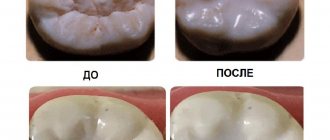- Classic comprehensive hygiene in 3 stages (ultrasound + air-flo + polishing) - 3,500 - 4,600 rub
- Periodontal cleaning of one segment (light) - 2,600 rub.
- Periodontal cleaning of one segment (medium degree) - 3,000 rub.
- Periodontal cleaning of one segment (severe) - 4,000 rub.
- Periodontal cleaning in the area of one tooth - 580 rub.
- Removal of a periodontal tooth during periodontal cleaning - 650 rub.
- Vektor therapy (Vector therapy) - 1st visit (90 min.) - 8,818 rub
- Vektor therapy (Vector therapy) - repeat visit (90 min.) - 7,334 rub
- Vektor therapy (Vector therapy) -1 tooth (20 min.) — 305 rub
Do your gums hurt? This means that you are developing an inflammatory process in your gums or have a painful tooth. When the cause of pain is in the tooth, the pain is local and does not spread to surrounding tissues. If your gums hurt, the cause may be periodontitis. Thus, the gum itself can be the cause of pain or it can serve as a symptom of another process.
When it comes to gum disease, the pain spreads to all or most of the teeth. This picture is especially characteristic of the development of gingivitis and periodontitis.
If you notice that the gums around a tooth or several teeth are swollen, red in color and bleeding, then we are most likely talking about gingivitis. If gingivitis is not cured, the process will go further and periodontitis will develop. If it seems to you that the gums near the tooth are swollen, then you need to promptly contact a periodontist for treatment, which must be carried out responsibly, since periodontitis can develop even if periodontitis is not treated well enough.
With periodontitis, the symptoms of gingivitis appear in a much more intense form, in addition, periodontal pockets begin to fester, and the necks of the teeth become exposed.
The initial stage of inflammation (gingivitis) - pain is felt in all gums. Further, when inflammation develops into periodontitis, pustules appear on the gums, and the pain intensifies around one/part of the teeth. The localization of the pain is explained by a periodontal abscess in the area of one of the periodontal pockets, in this case you may notice how the gums around a specific tooth are swollen. The main reason for the development of diseases of this nature is poor oral hygiene. The soft plaque covering the teeth tends to harden over time into a dense growth on the teeth, forming tartar. It is in the stone that pathogenic bacteria live comfortably, which provoke inflammatory processes in the gums and the appearance of pain. Therefore, it is necessary to both treat the gums and get rid of stone deposits, as well as eliminate carious areas of the tooth.
Why do ulcers appear on the gums, and is it always dangerous?
There are many possible reasons. To understand how dangerous the appearance of certain lesions on the gums is, you need to look at additional accompanying symptoms:
- in case it is trivial mechanical damage. The gums can be damaged by hard food, a toothbrush, or a foreign object. These lesions may resolve in 3-5 days. If a person does not brush his teeth, then infection is added to these damages, and healing may take several weeks.
- Sometimes ulcers can appear as a result of wearing orthodontic structures, braces or removable dentures.
Types of gum injuries
- Mechanical injury. The most common type of damage. The cause is usually external physical influence. Most often such injuries occur during a fall or from an external blow.
It is possible that injuries may occur during sports activities in strength martial arts - boxing, freestyle wrestling, judo, karate and other sports. Mechanical injuries are easier to diagnose, since in most cases they are accompanied by external injuries, such as bruises, bruises, and even skin tears.
- Chemical injury. Such gum injury may be the result of exposure to chemically active drugs. For an inattentive or in a hurry person, it is quite acceptable that he can confuse externally similar liquids, for example, vinegar and water, or a concentrated solution of manganese and currant juice. After such an impact, the gums receive extensive trauma.
The most common diseases of the oral cavity in which ulcers appear
- ulcerative necrotizing gingivitis. The cause of this disease is bacteria that multiply when immunity decreases. Extensive ulcers appear on the gums, regional lymph nodes become enlarged, and the temperature may rise
- chronic recurrent aphthous stomatitis. Up to 4-5 white spots first appear in the mouth, which later turn into ulcers. There is no temperature or other problems related to well-being. If such symptoms appear 1-2 times a year in small quantities, then there should be no cause for concern. Frequent occurrence is associated with weakened immunity and possible intestinal diseases, as well as allergies.
- acute herpetic stomatitis. Herpetic stomatitis occurs in a child when he first encounters the herpes virus. Many bubbles appear on the gums, which, after bursting, turn into ulcers that merge with each other. The gums are always bright red, and the ulcers themselves are very painful, the temperature may rise
How long does it take for gums to heal after tooth extraction - timing
How long it takes for the gums to heal after tooth extraction depends on many factors: the degree of trauma of the removal, whether sutures were applied, the possible addition of infectious inflammation of the socket, and the age of the patient. Healing of the hole after tooth extraction can be divided into partial and complete.
Partial epithelization of the wound occurs on average in 12 days (Fig. 5), but complete epithelization of the surface of the clot is observed in 20 to 25 days (Fig. 6). However, if inflammation of the socket occurs or after a complex tooth extraction, which is usually accompanied by major bone trauma, the healing time may increase by several days.
Reasons for slow healing –
- significant trauma to the bone and gums during removal (both due to the doctor’s indifference and as a result of sawing out the bone around the tooth with a drill during difficult removal),
- when a clot falls out of the socket (empty socket),
- development of alveolitis of the socket,
- the doctor left fragments or inactive fragments of bone tissue in the socket,
- if sharp bone fragments protrude through the mucous membrane,
- if the gum mucosa around the hole is very mobile, and the doctor did not apply stitches,
- antibiotics were not prescribed after a complex removal,
- patient's age.
First aid
If the temperature rises, you can take an antipyretic drug. In the future, before visiting a doctor, nothing should be done. Do not take antibiotics yourself or try to get into the ulcer with any object.
How to relieve symptoms of ulcers
- do not eat sour and salty foods
- food should be warm, no hot dishes or drinks
- Care should be taken to ensure that the child does not put dirty hands in his mouth
- teeth should be brushed, but make sure that the bristles do not touch the gums with ulcers
- It is recommended to rinse your mouth with herbal solutions (oak bark, chamomile) 3-4 times a day
You should be careful when using antibacterial solutions. They must be prescribed by a doctor. If such solutions are used incorrectly, they can provoke the development of thrush. The antibacterial agent will “kill” the beneficial microflora, which can result in a fungal infection.
Prevention of ulcers
- professional oral hygiene at least 2 times a year
- Regularly replacing your toothbrush
- Proper brushing of teeth at least 2 times a day
- using additional hygiene techniques such as irrigators, dental floss, and tongue scrapers
- Children should be monitored for bad habits such as putting dirty fingers and other objects into their mouths
- It is important to treat your teeth in a timely manner. Microbes that are found in carious teeth and rotten roots can serve as a source of infection for ulcers
If you have problems in the oral cavity, contact the specialists of the Center for Family Dentistry!
Saying goodbye to gum pain
If your gums are sore and swollen, what should you do first? No, don’t use a plot from your mother’s best friend’s neighbor’s great-grandmother. All “spells” for dental problems are in the hands of the dentist, and only he knows how to correctly “spell” gums from pain and bleeding.
Inflammatory processes occurring in the teeth and gums in the case of periodontitis and gingivitis are provoked, as already mentioned, by bacteria colonizing tartar. So, if you notice that your gums are swollen, what should you do with your right mind? That's right - remove stone deposits from teeth. Unfortunately, no toothbrush can “overpower” tartar plaque, so you need to go to the clinic for professional teeth cleaning. Only when the teeth are cleared of all deposits will therapeutic treatment be prescribed, including antibiotics, if the complexity of the case requires it.
Don’t ask about advanced inflammation: this is only a matter for the dentist. You can treat inflammation yourself only in the initial stages; it includes rinsing the teeth with a chlorhexidine solution and treating with cholisal gel.
The course is usually designed for 10 days. Procedures must be carried out after meals in the morning and evening. Such rinses are quite effective when the case is not advanced.
If your gums hurt not because of mild inflammation, but because of the development of severe and moderate periodontitis, then the treatment process will be different.
Periodontitis is the development of an inflammatory process at the apex of the tooth root, which leads to a periodontal abscess - the formation of a dental cyst - a sac of pus that can burst and leave a fistula opening. Under such circumstances, pain in the gums can be caused by caries or pulpitis. How to treat gums with periodontitis? Treatment in this case will consist of:
- removal of carious areas of dental tissue;
- nerve removal;
- treatment of root canals with medicinal paste and temporary filling;
- removal of stones;
- anti-inflammatory therapy of a general or local nature.
When to see a doctor?
You need to make an appointment with a dentist if you have the following symptoms:
- redness and bleeding of the gums,
- mild or intense pain,
- suppuration of soft tissues,
- bad breath,
- discomfort when eating and brushing teeth.
The listed signs indicate gum inflammation. There is no need to wait for them to disappear and put off visiting a doctor. Ignoring warning signs can lead to soft tissue infection, increased tooth mobility, and tooth loss.
Pain after treatment
Often discomfort between teeth occurs after treatment. This may indicate poor-quality filling and the development of infection inside the canal. In this case, you need to take an x-ray, with which you can immediately detect the pathology.
Important! Trauma to the gums can occur due to an “overhanging” filling that comes into contact with the gingival papilla.
You can detect a filling defect by using dental floss that gets stuck or breaks. Treatment requires correction of the filling or its replacement. Microtrauma from a filling or crown can cause discomfort in the first days after dental treatment. The pain goes away on its own after a few days.
Video - Gums hurt: what to do?
How to speed up wound healing after tooth extraction -
The best remedy that can speed up the healing of the gums after tooth extraction is the placement of sutures on the socket of the extracted tooth by a surgeon immediately after the tooth is extracted. Moreover, it is necessary that the edges of the gum mucosa be as close to each other as possible. This will speed up healing and reduce the risk of inflammation in the socket of the extracted tooth. But if you have already had a tooth removed without stitches, then topical oral products may help (see below).
Additional topical products - patients often ask if there is an ointment for healing wounds after tooth extraction... If you are not satisfied with how long it takes for the gums to heal after tooth extraction, then this process can really be accelerated. Rapid healing of wounds in the oral cavity is possible with the use of agents that accelerate the epithelization of wounds on the mucous membrane. These means include -
- Solcoseryl in gel form,
- Solcoseryl in the form of dental paste,
- Actovegin in the form of 20% gel.
It should be noted that these drugs also have a good analgesic effect. You can read about the specifics of their use after tooth extraction using the links above, but if you are a fan of “grandmother’s” remedies, then regular sea buckthorn oil may also come in handy (although its effect will be noticeably more modest).
Main reasons
There are many reasons that can cause gum discomfort. Some of them are harmless, and when the unfavorable factor is eliminated, the unpleasant symptom goes away on its own. If the pain is caused by diseases of the oral mucosa or teeth, treatment is required.
The following may cause temporary discomfort:
- Using a low-quality or hard brush.
- Traumatization of the gums by solid food.
- Taking certain medications.
If, after changing the brush to a softer one, your gums still continue to hurt, and trauma and medication are excluded, you can suspect one of the diseases of the oral cavity. In such cases, it is necessary to urgently visit the dentist.
Signs and consequences of tartar
Main causes of pain:
- Plaque. It contains a large number of pathogenic bacteria that cause inflammation and pain.
- Improper cleaning. “Plaques” are formed on the enamel, which are colonies of bacteria.
- External damaging factors. Various microtraumas can cause pathogenic microorganisms to penetrate into periodontal tissue, causing inflammation.
- Some diseases. Failure of the digestive and endocrine systems, as well as blood diseases, often cause pain in the gums.
If the pain spreads in the area of several teeth, then the cause most often lies in caries or an inflammatory process. In this case, it is important not only to relieve the unpleasant symptom, but also to cure the disease that caused it.
How to brush your teeth correctly











